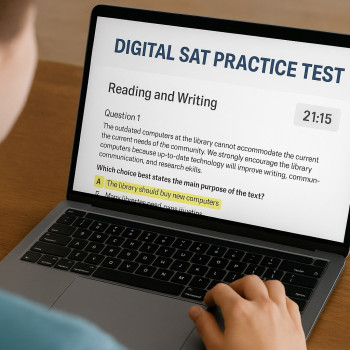Is a Higher SAT Score Worth It? A Friendly Guide for Students and Parents
Deciding whether to spend weeks or months chasing a higher Digital SAT score is one of those surprisingly emotional choices in the college application journey. It can feel like a simple math problem — higher score equals better chance — but in practice, the answer depends on context: which colleges you’re applying to, whether they’re test-optional, your academic record, and even scholarship thresholds. This article walks through a practical way to decide, with examples, a decision checklist, and a realistic timeline so you don’t trade sleep and sanity for a marginal gain that won’t move the needle.

Start Here: What “Boosting Admissions Chances” Really Means
When people talk about a higher SAT score boosting admissions chances, they usually mean one or more of these outcomes:
- Moving from a “reach” to a “match” or “safety” school on your list.
- Increasing the likelihood of receiving merit scholarships tied to score cutoffs.
- Improving the strength of your application when a school still considers scores as an important factor.
- Qualifying for specific programs or honors colleges that ask for higher scores.
None of these outcomes are guaranteed by test scores alone. Admissions officers look at a package: grades, course rigor, essays, recommendations, activities, and — yes — test scores. But in many scenarios, a strategic score increase can have real, measurable value.
Four Questions to Ask Before You Invest Time in Raising Your SAT Score
Answer these quickly to get clarity. Your honest answers will point you to a clear next step.
- Where are your target colleges in the score range? If your score is already within the middle 50% for admitted students at your top choices, a modest increase may not change outcomes much. If you’re below the 25th percentile at a school, a significant increase could matter.
- Are your colleges test-optional or test-required? Test-optional schools don’t require a score, but a good score can still strengthen an application. Test-required schools or places that use scores for placement/scholarships can be more directly impacted by improvements.
- Are scholarships tied to score cutoffs? Many merit awards use specific thresholds. Jumping from a 1270 to a 1400 (example numbers) could unlock thousands in merit aid.
- Do you have time to improve meaningfully before deadlines? If application deadlines are close and you can only prepare a little, the effort might be better spent on essays or portfolio pieces. If you have months, targeted prep could produce meaningful gains.
How Colleges Use SAT Scores — The Practical Reality
Colleges use SAT scores differently. Some weigh them heavily as a predictive academic measure. Others treat them as a supplement or ignore them entirely under test-optional policies. Here’s the practical breakdown:
- Selective, test-using colleges: Score ranges matter. Moving into the middle 50% can improve chances, or at least prevent an application from being automatically deprioritized. For very selective schools, even small differences matter because applicant pools are deep.
- Test-optional colleges: If your other credentials are exceptional, you might be stronger without a score. If you’re from an under-resourced school, a higher SAT can provide objective evidence of readiness.
- State schools and placements: Some public universities use SAT scores for course placement — a higher score might let you skip remedial classes or enter higher-level courses.
- Scholarship-driven cases: For many colleges, the biggest financial impact of a higher SAT is access to merit scholarships tied to score ranges.
Three Practical Scenarios: When a Higher Score Usually Helps
These aren’t absolutes, but they help you visualize real outcomes.
- The Score Gap Scenario: Your score is below the 25th percentile at a target school. Improving to the middle 50% often changes your application from a reach to a match.
- The Scholarship Threshold Scenario: A school awards significant merit scholarships at or above a specific score. Raising your score past that cutoff can directly reduce college cost.
- The Strengthening Profile Scenario: You have weaker grades or fewer APs; a notable SAT score can serve as objective evidence of academic potential.
One Caveat: Diminishing Returns
As you get closer to the top of the scale, each point becomes harder to earn and often yields smaller admissions gains. If you are already above the 75th percentile at your dream colleges, extra improvement might have little to no practical effect on admission outcomes.
Decision Table: Quick Guide to Whether You Should Retake the SAT
| Situation | Short Answer | Why | Recommended Action |
|---|---|---|---|
| Score < 25th percentile at top-choice schools | Yes — retake | Raises match probability; addresses deficit | Structured prep (3–4 months), diagnostic, target weak areas |
| Score within middle 50% | Maybe | Little room to change outcome unless aiming for scholarships | Consider focused improvement if scholarships possible; otherwise prioritize essays |
| Score > 75th percentile | Probably not | Diminishing returns for admissions advantage | Use time for APs, activities, or polishing application materials |
| Test-optional schools with strong grades | Maybe not | Scores add less than strong GPA & unique extracurriculars | Submit score only if it strengthens narrative; otherwise skip |
| Close to scholarship cutoffs | Yes | Direct financial benefit | Targeted prep focused on sections that will push you over threshold |
How Much Improvement Is Realistic — and How Long It Takes
Realistic gains depend on your baseline, study quality, and time invested. Here are general patterns from practice and prep experiences:
- Baseline under 900: With a focused 3–4 month plan, 120–200+ point gains are possible because many test fundamentals can be learned quickly.
- Baseline 900–1200: A realistic 50–150 point increase with targeted practice and official practice tests over 2–4 months.
- Baseline 1200–1400: Expect smaller improvements (30–80 points) from fine-tuning timing, advanced question practice, and error pattern correction.
- Baseline 1400+: Gains are incremental and require deeper mastery — think 10–40 points typically, and diminishing returns apply.
These are guidelines; individual results vary. The key is efficient practice that focuses on weaknesses and uses real Digital SAT practice materials.
Concrete Steps to Decide — A Simple Flow
Follow this four-step flow to make an evidence-based choice.
- Find the score ranges for your target schools. Use each college’s published mid-50% SAT range or a trusted college search tool to see where you stand.
- Map your current score onto those ranges. If you’re below or near the lower quartile for multiple targets, improvement is more valuable.
- Check scholarship thresholds. Know the cutoffs that unlock merit money — those are high-impact targets.
- Estimate prep ROI. Ask: Can I realistically improve enough before deadlines? If yes, plan a targeted study schedule. If no, redirect effort to other application strengths.
What Good Prep Looks Like (So You Don’t Waste Time)
Time is your most precious resource in senior year. A wasteful study routine chews hours without moving the score. Use this efficient approach:
- Diagnostic first: Take a full, timed Digital SAT practice test to identify the largest error patterns.
- Focus on weaknesses: Don’t grind what you already ace. If algebra is the problem, drill targeted problems and strategy for that domain.
- Quality over quantity: Forty minutes of intentional practice with explanations is better than four hours of passive question clicking.
- Practice full, timed tests weekly: Build stamina and reduce test-day surprises. Review every missed question thoroughly.
- Get feedback: A tutor, teacher, or trusted coach can identify bad habits faster than self-study alone.
The Role of Personalized Tutoring
Personalized tutoring makes the biggest difference when your weak points are specific and recurring — like timing, geometry, or evidence-based reading strategies. A tutor can design a tailored plan, track progress, and adjust practice to focus on the highest-leverage skills. For many families, an investment in 1-on-1 guidance speeds progress and reduces wasted effort. Services that combine expert tutors with data-driven insights can be especially effective for squeezing out those extra points while keeping stress low. Sparkl’s personalized tutoring, for example, offers one-on-one guidance, tailored study plans, and AI-informed insights to help students focus on what truly moves the score.
When You Might Choose Not to Retake
There are perfectly valid reasons to stop retaking the SAT:
- You’re already comfortably above the target ranges for all schools on your list.
- Applications and essays need polishing and will benefit more from your attention.
- Stress and mental health concerns make additional testing counterproductive.
- Additional testing won’t affect scholarship eligibility or program admissions.
Real-World Examples: Translating Scores into Decisions
Here are three compact, realistic scenarios to illustrate the decision process.
- Case A — The Improving Junior: Maya scored a 1160 in March and targets three public universities with mid-50% ranges of 1150–1350. She’s below the top of the range and qualifies for a modest scholarship at one school if she reaches 1300. Decision: Retake, focusing on math fundamentals and timed practice to aim for 120–140-point improvement.
- Case B — The Busy Senior: Jamal scored a 1430 and applies to a mix of test-optional schools where his GPA and portfolio shine. He’s above the 75th percentile at many targets. Decision: Skip retake; spend time refining essays and recommendations.
- Case C — The Cost-Conscious Family: Priya scored a 1250; a state flagship offers $5,000 merit at 1350. With a solid study plan and tutoring, she can reasonably aim for that bump. Decision: Targeted prep + scholarship-focused retake.

Timeline and Practical Plan If You Decide to Retake
Here’s a compact, realistic timeline you can adapt based on how much time you have before deadlines.
- 3–4 months before test: Diagnostic test, create a plan, start focused content work (3–5 hours/week).
- 6–8 weeks before test: Increase to 6–8 hours/week; begin weekly full-length practice tests under official timing.
- 2–3 weeks before test: Finalize strategies for each section, practice pacing, and review frequent mistake types.
- Test week: Light review, rest, practice relaxation and timing strategies — no cramming.
How to Measure Whether the Retake Was Worth It
After scores come back, use three metrics to judge the ROI of your prep:
- Admissions alignment: Did your new score move you into a stronger band for any target schools?
- Scholarship impact: Did the new score unlock any merit aid or program eligibility?
- Personal cost-benefit: Consider time, stress, and other trade-offs. If the score helped and stress stayed manageable, it was likely worth it.
Final Checklist — Make the Decision Today
Print this checklist and use it with your student and parent(s) to make a calm, informed choice.
- Know the mid-50% SAT ranges for each college on your list.
- Identify scholarship cutoffs tied to SAT scores.
- Take or review a recent full-length diagnostic Digital SAT.
- Estimate realistic point gains for the prep time you have.
- Decide whether the marginal gain will change admissions or financial outcomes.
- If choosing to prep, pick an efficient plan: focused practice, weekly sim tests, and expert feedback.
Parting Thoughts: Balance Goals and Well-Being
The decision to retake the Digital SAT is both strategic and personal. Think of the score as one powerful piece in your admission puzzle — sometimes the piece that unlocks doors, and sometimes an extra puzzle piece you don’t need to chase. Take a test, gather data, talk through the priorities with your family, and weigh the emotional and financial costs. If you choose structured, personalized help, it can make the process faster and less stressful — and that’s why many families find value in one-on-one tutoring and tailored study plans that focus on what truly moves the needle.
Remember: a higher number on a test is helpful, but it’s not the only story you bring to colleges. Your voice in essays, the depth of your activities, your recommendations, and the unique perspective you bring often matter just as much — sometimes more. Choose the path that strengthens the whole application, not just the score.
Need help deciding or building a plan?
If you want a practical, personalized review of whether a retake makes sense for your specific college list — including a realistic gain estimate and a study plan that respects your time — consider scheduling a diagnostic session with an expert. Personalized tutoring that blends 1-on-1 guidance, tailored study plans, and AI-driven insights can save time and target the skills that will make the real difference. Whatever path you choose, stay curious, be strategic, and take care of yourself during the process.
Good luck — you’ve got this.
The admissions journey can be long and imperfect, but with clear data, honest priorities, and focused work, you’ll make choices that serve your goals and your well-being. Breathe, plan, and move forward with purpose.















No Comments
Leave a comment Cancel